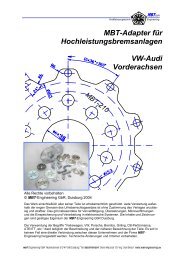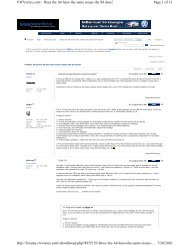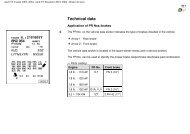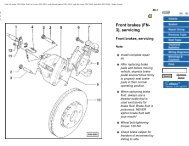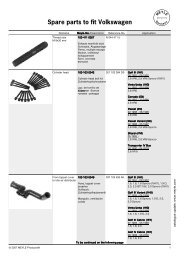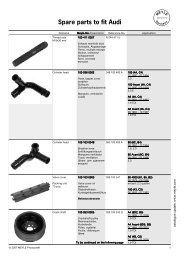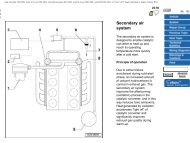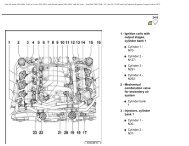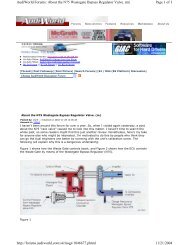VW MKII A2 MK2 Golf Jetta Fox Service Manual - VAGLinks.com
VW MKII A2 MK2 Golf Jetta Fox Service Manual - VAGLinks.com
VW MKII A2 MK2 Golf Jetta Fox Service Manual - VAGLinks.com
You also want an ePaper? Increase the reach of your titles
YUMPU automatically turns print PDFs into web optimized ePapers that Google loves.
17.10 Accelerator pump check<br />
preparation<br />
A Vacuum pump connection<br />
B Plug vacuum connection (3-point unit)<br />
C Plug vacuum connection (4-point unit)<br />
Accelerator pump<br />
9 To make this check, the carburettor must<br />
be removed and you will need a vacuum<br />
pump and an M8 x 20 mm bolt.<br />
10 Detach the vacuum hoses from the<br />
three/four point unit then connect up the<br />
vacuum pump to the three/four point unit at<br />
“A” (see illustration). Plug connection B (and<br />
C on four point unit). Apply vacuum with the<br />
pump to hold the diaphragm pushrod in the<br />
overrun/cut-off position and to give a<br />
clearance between the fast idle speed and<br />
diaphragm pushrod.<br />
17.13 Loosen screw (A) and turn cam plate<br />
(B) in direction required to adjust<br />
accelerator pump injection capacity<br />
17.15 Lock lever clearance with throttle<br />
valves closed<br />
Fuel and exhaust systems - carburettor models 4A•19<br />
11 Pivot the warm-up lever up to the point<br />
where the throttle valve control pin has<br />
clearance and insert the M8 x 20 mm bolt to<br />
hold the warm-up lever in this position (see<br />
illustration).<br />
12 Hold the carburettor over a funnel and<br />
measuring glass then slowly open the throttle<br />
valve lever fully five times allowing at least 3<br />
seconds per stroke. Divide the total quantity<br />
by five and check the resultant injection<br />
capacity against that specified.<br />
13 If adjustment is necessary, loosen screw<br />
A and rotate the cam plate B in the required<br />
direction to increase or decrease the injection<br />
capacity (see illustration). On <strong>com</strong>pletion,<br />
retighten the screw and seal in position with<br />
locking <strong>com</strong>pound.<br />
14 The accelerator pump injection capacity<br />
can also be checked with the carburettor in<br />
the vehicle but as specialised equipment is<br />
required, this is a task best entrusted to your<br />
<strong>VW</strong> dealer.<br />
Throttle valve<br />
15 For the basic Stage ll valve adjustment,<br />
proceed as described in Section 16,<br />
paragraphs 6 and 7 whilst referring to the<br />
ac<strong>com</strong>panying illustration (see illustration).<br />
Three/four point unit - vacuum pump<br />
method<br />
16 Detach the vacuum hoses from the unit<br />
and attach a vacuum pump to connection “1”<br />
(see illustration). Apply vacuum to pull the<br />
diaphragm pushrod to the idle point and then<br />
measure the amount of rod protrusion, which<br />
must be as specified.<br />
17 To check the overrun cut-off point, plug<br />
off the vacuum connection 3, then apply<br />
increased vacuum with the vacuum pump.<br />
This should cause the diaphragm pushrod to<br />
move to the overrun/cut-off point. Measure<br />
the rod protrusion (a) which should now be<br />
1.0 mm. The pushrod should hold at this<br />
position for one minute.<br />
18 If rod protrusion is incorrect, or will not<br />
hold for the specified period, then the<br />
diaphragm or three/four point unit are<br />
probably leaking and in need of renewal.<br />
17.16 Three or four point unit check<br />
preparation<br />
Pushrod to idle point a = 8.5 mm<br />
1 Vacuum connection<br />
2 and 3 Plug these connections<br />
1081 <strong>VW</strong> <strong>Golf</strong> & <strong>Jetta</strong><br />
17.11 Accelerator pump adjustment check<br />
showing warm-up lever (A) lever (B) and<br />
bolt (C)<br />
Three/four point unit - engine vacuum<br />
method<br />
19 Run the engine to normal operating<br />
temperature then switch it off. Remove the air<br />
cleaner and close the vacuum line from the<br />
carburettor to the temperature regulator.<br />
20 With the engine stopped, check the<br />
diaphragm pushrod (A) (see illustration) is<br />
fully extended to approximately 14.5 mm.<br />
21 Start the engine and let it idle. The<br />
diaphragm pushrod must now be extended<br />
approximately 8.5 mm (three-point unit), or<br />
9.5 mm (four-point unit), and must just<br />
contact the fast idle adjustment screw.<br />
22 On models with air conditioning, switch<br />
on the air conditioner with the blower on<br />
maximum speed. The diaphragm pushrod<br />
dimension should be approximately 12.0 mm.<br />
23 To check the overrun cut-off point, run the<br />
engine at idle speed.<br />
24 On the four-point unit, disconnect and<br />
plug the pink-coloured hose at the control<br />
valve.<br />
25 Using a screwdriver, hold the primary<br />
throttle valve fully closed to prevent it moving<br />
to the overrun cut-off point.<br />
26 Disconnect the plug from the<br />
idling/overrun control valve, then check that<br />
the diaphragm pushrod dimension is<br />
approximately 1.5 mm.<br />
27 To check the unit for leaks, first, on the<br />
three-point unit only, pinch the hose between<br />
the unit and Y-piece.<br />
17.20 Three/four point unit with pushrod<br />
(A) and cold idling adjusting screw (B) in<br />
idling position<br />
4A



